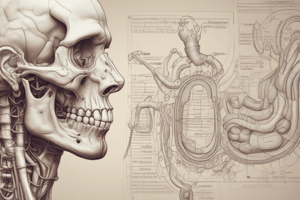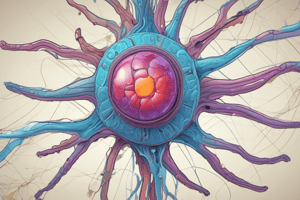Podcast
Questions and Answers
Which specialty focuses on studying all of the structures of the ankle and foot?
Which specialty focuses on studying all of the structures of the ankle and foot?
A scientist studying how the body utilizes food and fluids during a marathon is most likely a(n) ________.
A scientist studying how the body utilizes food and fluids during a marathon is most likely a(n) ________.
What is the smallest independently functioning biological unit of an organism?
What is the smallest independently functioning biological unit of an organism?
A collection of similar tissues that performs a specific function is known as an ________.
A collection of similar tissues that performs a specific function is known as an ________.
Signup and view all the answers
The body system that provides structural support and enables movement is the ________.
The body system that provides structural support and enables movement is the ________.
Signup and view all the answers
Metabolism can best be defined as the ________.
Metabolism can best be defined as the ________.
Signup and view all the answers
Adenosine triphosphate (ATP) is crucial because it ________.
Adenosine triphosphate (ATP) is crucial because it ________.
Signup and view all the answers
Cancer cells are often described as lacking ________.
Cancer cells are often described as lacking ________.
Signup and view all the answers
Humans urgently need a continuous supply of ________.
Humans urgently need a continuous supply of ________.
Signup and view all the answers
After eating, nerve cells in the stomach respond to food's distension by relaying information to ________.
After eating, nerve cells in the stomach respond to food's distension by relaying information to ________.
Signup and view all the answers
Which physiological response occurs when blood vessels in the skin constrict?
Which physiological response occurs when blood vessels in the skin constrict?
Signup and view all the answers
Which process is an example of a normal physiological process that uses a positive feedback loop?
Which process is an example of a normal physiological process that uses a positive feedback loop?
Signup and view all the answers
What is the stance of the body in the 'normal anatomical position'?
What is the stance of the body in the 'normal anatomical position'?
Signup and view all the answers
The midsagittal plane divides the body into which of the following?
The midsagittal plane divides the body into which of the following?
Signup and view all the answers
Which region is located superior to the popliteal region?
Which region is located superior to the popliteal region?
Signup and view all the answers
In which cavity is the heart located?
In which cavity is the heart located?
Signup and view all the answers
For which discovery did Wilhelm Röntgen receive the Nobel Prize in 1901?
For which discovery did Wilhelm Röntgen receive the Nobel Prize in 1901?
Signup and view all the answers
Which imaging technique is best used to study nutrient uptake by cancer cells?
Which imaging technique is best used to study nutrient uptake by cancer cells?
Signup and view all the answers
Which imaging study is considered safest for use during pregnancy?
Which imaging study is considered safest for use during pregnancy?
Signup and view all the answers
Which is a disadvantage of MRI scans?
Which is a disadvantage of MRI scans?
Signup and view all the answers
Flashcards
Specialties focusing on structures
Specialties focusing on structures
Regional anatomy studies all structures of the ankle and foot.
Scientist studying body during marathon
Scientist studying body during marathon
An exercise physiologist studies how the body uses foods and fluids during endurance activities.
Smallest biological unit
Smallest biological unit
A cell is the smallest independently functioning unit of an organism.
Collection of similar tissues
Collection of similar tissues
Signup and view all the flashcards
Body system for support and movement
Body system for support and movement
Signup and view all the flashcards
Metabolism
Metabolism
Signup and view all the flashcards
Importance of ATP
Importance of ATP
Signup and view all the flashcards
Cancer cell characteristic
Cancer cell characteristic
Signup and view all the flashcards
Human need urgency
Human need urgency
Signup and view all the flashcards
True statement about nutrients
True statement about nutrients
Signup and view all the flashcards
Positive feedback loop in physiology
Positive feedback loop in physiology
Signup and view all the flashcards
Normal anatomical position
Normal anatomical position
Signup and view all the flashcards
Midsagittal plane
Midsagittal plane
Signup and view all the flashcards
Location of the lumbar region
Location of the lumbar region
Signup and view all the flashcards
Mediastinum
Mediastinum
Signup and view all the flashcards
X-rays discovery
X-rays discovery
Signup and view all the flashcards
Imaging technique for cancer nutrient uptake
Imaging technique for cancer nutrient uptake
Signup and view all the flashcards
Safe imaging during pregnancy
Safe imaging during pregnancy
Signup and view all the flashcards
Disadvantages of MRI
Disadvantages of MRI
Signup and view all the flashcards
Coronal plane
Coronal plane
Signup and view all the flashcards
Study Notes
Anatomy and Physiology Study Notes
-
Specializing in Ankle and Foot Structures: Regional anatomy is the specialty that studies the structures of the ankle and foot.
-
Marathon Runner Physiology: An exercise physiologist studies how the body uses nutrients during physical activity like a marathon run.
-
Smallest Biological Unit: The cell is the smallest independently functioning unit of an organism.
-
Tissues and Organs: A collection of similar tissues working together is an organ. A group of organs working together forms a system.
-
Support and Movement: The skeletal and muscular systems are responsible for structural support and movement.
-
Metabolism: Metabolism is the sum of all chemical reactions in the organism.
-
Energy Storage: Adenosine triphosphate (ATP) stores energy for use by cells, releasing that energy as needed.
-
Cancer Cell Characteristics: Cancer cells lack differentiation, meaning they do not perform specialized functions of healthy cells.
-
Vital Resource: Oxygen is the most critical resource for human survival.
-
Nutrient Essentiality: All classes of nutrients are essential. Micronutrients, like vitamins and minerals, need to be continuously consumed. Macronutrients (carbs, lipids, proteins) aren't micro- but are also vital.
-
Body Response to Cold: When cold, the body shifts to conserve heat.
-
Nerve Cell Communication: Stomach distension (due to food) is relayed by nerve cells to a central control center.
-
Heat Regulation Mechanisms: Responding to heat, the body adjusts, possibly using sweat glands and slowing breathing, to lose heat. The use of positive feedback loops like regulation body heat does not use positive feedback but negative.
-
Positive Feedback Loops: Childbirth is an example of positive feedback loop. This is not an example of normal physiological process using positive feedback loop
-
Anatomical Position: The anatomical position is described as standing facing the observer with the arms at the sides and palms forward, with feet slightly apart..
-
Anatomical Planes: Dividing a fruit in half creates a sagittal plane or a longitudinal plane
-
Body Regions: The lumbar region is inferior to the umbilical region and superior to the gluteal region.
-
Cavities: The heart is in the mediastinum within the thoracic cavity. The cranial cavity is at the top and the posterior (dorsal) cavity covers the back of the body.
-
Nobel Prize Winner and X-Rays: Wilhelm Röntgen discovered X-rays and earned the first Nobel Prize for this.
-
Cancer Cell Nutrient Uptake Study: Positron Emission Tomography (PET) is the most suitable technique.
-
Safe Imaging During Pregnancy: Ultrasound is the safest imaging method for pregnancy.
-
MRI Disadvantages: MRI scans have high costs and require the patient to be confined in a metal tube to avoid distortions from magnetic fields, for an extended duration.
Studying That Suits You
Use AI to generate personalized quizzes and flashcards to suit your learning preferences.
Description
Test your knowledge of anatomy and physiology with this focused quiz. Explore the structures of the ankle and foot, the role of metabolism, and the characteristics of cancer cells. Perfect for students and enthusiasts alike!




